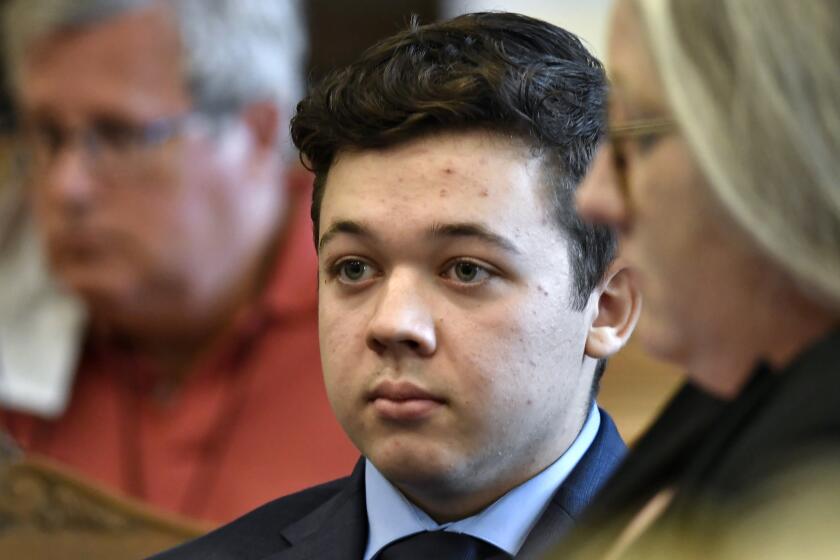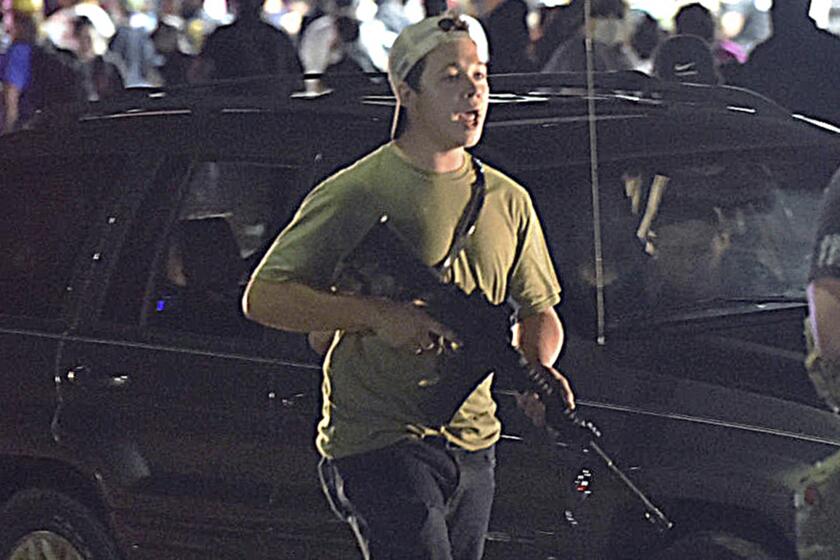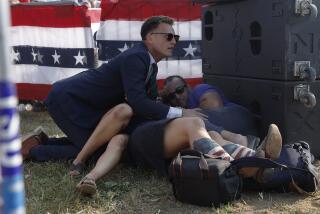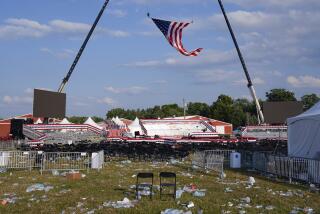Kyle Rittenhouse shot first man at close range, says forensic pathologist at trial

- Share via
KENOSHA, Wis. — The first man killed by Kyle Rittenhouse on the streets of Kenosha was shot at close range of just a few feet and had soot injuries that could indicate he had his hand over the barrel of Rittenhouse’s rifle, a pathologist testified Tuesday as the prosecution completed its side of the case.
But it was unclear from video whether Joseph Rosenbaum was grabbing for Rittenhouse’s gun or trying to swat it away, said the witness, Dr. Doug Kelley, a forensic pathologist with the Milwaukee County medical examiner’s office.
Prosecutors soon afterward rested their murder case after 5 1/2 days of testimony in which some of its own witnesses often bolstered Rittenhouse’s claim of self-defense. His lawyers have suggested he was afraid his gun was going to be taken away and used against him.
The defense then began presenting its side.
Rittenhouse, now 18, shot two men to death and wounded a third during a night of turbulent protests against racial injustice in Kenosha in the summer of 2020.
The former police youth cadet from Antioch, Ill., was 17 when he went to Kenosha with an AR-style semi-automatic rifle and a medical kit in what he said was an effort to safeguard property from the sometimes-violent demonstrations that broke out over the shooting of Jacob Blake, a Black man, by a white Kenosha police officer.
Prosecutors have portrayed Rittenhouse as the aggressor in the series of shootings.
He could get life in prison if convicted of the most serious charges against him.
On Tuesday, the jury watched drone video that was zoomed-in and slowed down to show Rittenhouse wheeling around and shooting Rosenbaum at close range.
Kelley said Rosenbaum was shot four times by someone who was within four feet of him. He testified that Rosenbaum was first wounded in the groin and then in the hand and thigh as he faced Rittenhouse, and then was shot in the head and in the back.
A judge says prosecutors can’t argue that a man who shot three people, killing two, during a protest against police brutality in Wisconsin is linked to the Proud Boys white nationalist group.
Those final two shots were at a downward angle, as if Rosenbaum was horizontal to Rittenhouse, Kelley said. Prosecutors have said this indicates Rosenbaum was falling forward, while defense attorney Mark Richards said Rosenbaum was lunging.
Kelley said both were possible.
Kelley also said Rosenbaum’s hand was “in close proximity or in contact with the end of that rifle.”
On cross-examination, Richards pointed out the small injuries from soot on Rosenbaum’s hand and said: “So that hand was over the barrel of Mr. Rittenhouse’s gun when his hand was shot.”
“That makes sense,” Kelley said.
A prosecutor later asked Kelley if Rosenbaum could have been swiping the gun away. Kelley said he couldn’t say, based on the video, what Rosenbaum was doing at the time.
The drone video was the clearest video yet of the shooting that set in motion the bloodshed that followed moments later: Rittenhouse killed Anthony Huber, a 26-year-old protester seen on bystander video hitting Rittenhouse with a skateboard. Rittenhouse then wounded Gaige Grosskreutz, a 27-year-old protester and volunteer medic who came at Rittenhouse with a gun of his own.
Kenosha Det. Ben Antaramian testified that at some point in their investigation, authorities learned someone had recorded drone video. The video had played on a Fox News segment.
Prosecutors said they received a low-resolution copy earlier in their investigation but weren’t given a high-definition one until Friday, Day 5 of the trial.
Last week, witnesses testified that Rosenbaum, 36, was “hyperaggressive” and “acting belligerently” that night and threatened to kill Rittenhouse at one point. One witness said Rosenbaum was gunned down after he chased Rittenhouse and lunged for the young man’s rifle.
On Monday, Grosskreutz testified that he pointed his own Glock pistol at Rittenhouse before he was shot in the arm.
States must be able to limit gun carry to promote the safety of the public square and protect the freedoms of assembly and speech.
Wisconsin’s self-defense law allows someone to use deadly force only if “necessary to prevent imminent death or great bodily harm.” The jury must decide whether Rittenhouse believed he was in such peril and whether that belief was reasonable under the circumstances.
On Tuesday, Rittenhouse turned his head and averted his eyes from a defense-table monitor as prosecutors displayed medical examiner photographs of Huber’s body on a gurney, a gunshot wound to his chest clearly visible, and breathed deeply as autopsy photos of Rosenbaum showing his injuries were displayed for the jury.
A few jurors also seemed to find it difficult to look for long at the images, one glancing up at a monitor over her shoulder, then looking straight ahead.
Later, Rittenhouse appeared to smile as attorneys used his rifle to try to measure the distance between the two men at the time of Rosenbaum’s shooting. He stood up at one point for a better view.
While Rittenhouse is white, as were those he shot, the case has stirred racially fraught debate over vigilantism, the right to bear arms, and the unrest that erupted around the U.S. that summer over police violence against Black people.
Bauer reported from Madison, Wis.; Forliti from Minneapolis; Webber from Fenton, Mich. Associated Press writer Michael Tarm contributed from Kenosha.
More to Read
Sign up for Essential California
The most important California stories and recommendations in your inbox every morning.
You may occasionally receive promotional content from the Los Angeles Times.















